Application of Large-Scale, Multi-Resolution Watershed Modeling Framework Using the Hydrologic and Water Quality System (HAWQS)
Abstract
:1. Introduction
2. Framework of HAWQS and Watershed Modeling
2.1. SWAT Model
2.2. HAWQS Framework
- Atmosphere Deposition—National Atmospheric Deposition Program (NADP) [24]
- Climate—Parameter-elevation Regressions on Independent Slopes Model (PRISM) [25]
- Land Use (non-agricultural)—National Land Cover Database (NLCD) [26]
- Land Use (agricultural)—National Agricultural Statistics Service (NASS) [27]
- Reservoirs—National Inventory of Dams (NID) [28]
- River Discharge—United States Geological Survey (USGS) [29]
- Soil—States Derived from the NRCS State Soil Geographic (STATSGO) [30]
- Topography—United States Geological Survey (USGS) [31]
- Water Usage—United States Geological Survey (USGS) [32]
2.2.1. Initialization
2.2.2. Customization
2.2.3. Output Management
2.2.4. Output Demonstration
3. Implementation of the HAWQS
3.1. Study Area
3.2. Watershed Setup with the HAWQS Interface
3.2.1. Step 1: Initialization of the Watershed
3.2.2. Step 2: Customization of SWAT Input Data
3.2.3. Step 3: Run SWAT Project Tasks
3.3. Verification of the SWAT Model
3.4. Results
3.4.1. Results of Calibration and Validation
3.4.2. HAWQS Summary Charts
5. Conclusions
Acknowledgments
Author Contributions and Additional Information
Conflicts of Interest
Appendix A
| Water Balance | ||||
|---|---|---|---|---|
| Parameter | Description | LB | UB | Default |
| SFTMP | Snowfall temperature (°C) | −5 | 5 | 1 |
| SMTMP | Snow melt base temperature (°C) | −5 | 5 | 0.5 |
| SMFMX | Melt factor for snow on 21 June (mm·H2O/°C -day) | 0 | 10 | 4.5 |
| SMFMN | Melt factor for snow on 21 December (mm·H2O/°C -day) | 0 | 10 | 4.5 |
| TIMP | Snow pack temperature lag factor | 0 | 1 | 1 |
| ESCO | Soil evaporation compensation factor | 0 | 1 | 0.95 |
| EPCO | Plant uptake compensation factor | 0 | 1 | 1 |
| IPET | Potential evapotranspiration (PET) method [Penman-Monteith/Priestley-Taylor/Hargreaves] | |||
| Surface Runoff | ||||
|---|---|---|---|---|
| Parameter | Description | LB | UB | Default |
| CNCOEF | Plant ET curve number coefficient | 0.5 | 2 | 1 |
| SURLAG | Surface runoff lag time | 0.5 | 24 | 4 |
| ICN | Daily curve number calculation method [Soil moisture/Plant Evapotranspiration] | |||
| ICRK | Daily curve number calculation method [No model crack flow/Model crack flow in soil] | |||
| Nutrient Cycling | ||||
|---|---|---|---|---|
| Parameter | Description | LB | UB | Default |
| RCN | Concentration of nitrogen in rainfall (mg N/L) | 0 | 15 | 1 |
| CDN | Denitrification exponential rate coefficient | 0 | 3 | 0 |
| SDNCO | Denitrification threshold water content | 0 | 1 | 0 |
| NPERCO | Nitrate percolation coefficient | 0 | 1 | 0.2 |
| PPERCO | Phosphorus percolation coefficient (10 m3/Mg) | 10 | 17.5 | 10 |
| PHOSKD | Phosphorus soil partitioning coefficient (m3/Mg) | 100 | 200 | 175 |
| PSP | Phosphorus sorption coefficient | 0.01 | 0.7 | 0.4 |
| Reaches | ||||
|---|---|---|---|---|
| Parameter | Description | LB | UB | Default |
| MSK_COL1 | Calibration coefficient used to control impact of the storage time constant for normal flow | 0 | 10 | 0 |
| MSK_COL2 | Calibration coefficient used to control impact of the storage time constant for low flow | 0 | 10 | 3.5 |
| MSK_X | Weighting factor controlling relative importance of inflow rate and outflow rate in determining water storage in reach segment | 0 | 0.3 | 0.2 |
| TRANSRCH | Fraction of transmission losses from main channel that enter deep aquifer | 0 | 1 | 0 |
| EVRCH | Reach evaporation adjustment factor | 0.5 | 1 | 0.4 |
| PRF | Peak rate adjustment factor for sediment routing in the main channel | 0 | 2 | 1 |
| SPCON | Linear parameter for calculating the maximum amount of sediment that can be reentrained during channel sediment routing | 0.00001 | 0.01 | 0.001 |
| SPEXP | Exponent parameter for calculating sediment reentrained in channel sediment routing | 1 | 1.5 | 1.2 |
| ADJ_PKR | Peak rate adjustment factor for sediment routing in the subbasin (tributary channels) | 0.5 | 2 | 0.5 |
| IRTE | Calibration coefficient used to control impact of the storage time constant for normal flow [Variable storage/Muskingum] | |||
| IDEG | Channel degradation code [Channel dimension updated No/Yes] | |||
| IWQ | In-stream water quality code [In-stream nutrient and pesticide No/Yes] | |||
Appendix B
| Pothole Parameters | ||||
|---|---|---|---|---|
| Parameter | Description | LB | UB | Default |
| POT_FR | Fraction of HRU area that drains into pothole | 0 | 1 | 0 |
| POT_TILE | Average daily outflow to main channel from tile flow if drainage tiles are installed in the pothole | 0 | 100 | 0 |
| POT_VOLX | Maximum volume of water stored in the pothole | 0 | 100 | 0 |
| POT_VOL | Initial volume of water stored in the pothole | 0 | 100 | 0 |
| SED_CON | Sediment concentration in runoff, after urban BMP is applied | 0 | 5000 | 0 |
| ORGN_CON | Organic nitrogen concentration in runoff, after urban BMP is applied | 0 | 100 | 0 |
| ORGP_CON | Organic phosphorus concentration in runoff, after urban BMP is applied | 0 | 50 | 0 |
| SOLN_CON | Soluble nitrogen concentration in runoff, after urban BMP is applied | 0 | 10 | 0 |
| SOLP_CON | Soluble phosphorus concentration in runoff, after urban BMP is applied | 0 | 3 | 0 |
Appendix C
| Reach Output Variables | |
|---|---|
| Parameter | Description |
| FLOW_IN | Average daily streamflow into reach (m3/s) |
| FLOW_OUT | Average daily streamflow out of reach (m3/s) |
| EVAP | Average daily loss of water from reach by evaporation (m3/s) |
| TLOSS | Average daily loss of water from reach by transmission (m3/s) |
| SED_IN | Sediment transported with water into reach (metric·tons) |
| SED_OUT | Sediment transported with water out of reach (metric·tons) |
| SEDCONC | Concentration of sediment in reach (mg/L) |
| ORGN_IN | Organic nitrogen transported with water into reach (kg·N) |
| ORGN_OUT | Organic nitrogen transported with water out of reach (kg·N) |
| ORGP_IN | Organic phosphorus transported with water into reach (kg·P) |
| ORGP_OUT | Organic phosphorus transported with water out of reach (kg·P) |
| NO3_IN | Nitrate transported with water into reach (kg·N) |
| NO3_OUT | Nitrate transported with water out of reach (kg·N) |
| NH4_IN | Ammonium transported with water into reach (kg·N) |
| NH4_OUT | Ammonium transported with water out of reach (kg·N) |
| NO2_IN | Nitrite transported with water into reach (kg·N) |
| NO2_OUT | Nitrite transported with water out of reach (kg·N) |
| MINP_IN | Mineral phosphorus transported with water into reach (kg·P) |
| MINP_OUT | Mineral phosphorus transported with water out of reach (kg·P) |
| CHLA_IN | Chlorophyll-a transported with water into reach (kg) |
| CHLA_OUT | Chlorophyll-a transported with water out of reach (kg) |
| CBOD_IN | Carbonaceous biochemical oxygen demand transported into reach (kg·O2) |
| CBOD_OUT | Carbonaceous biochemical oxygen demand transported out of reach (kg·O2) |
| DISOX_IN | Dissolved oxygen transported into reach (kg·O2) |
| DISOX_OUT | Dissolved oxygen transported out of reach (kg·O2) |
| SOLPST_IN | Soluble pesticide transported with water into reach (mg a.i.) |
| SOLPST_OUT | Soluble pesticide transported with water out of reach (mg a.i.) |
| SORPST_IN | Pesticide sorbed to sediment transported with water into reach (mg a.i.) |
| SORPST_OUT | Pesticide sorbed to sediment transported with water out of reach (mg a.i.) |
| REACTPST | Loss of pesticide from water by reaction (mg a.i.) |
| VOLPST | Loss of pesticide from water by volatilization (mg a.i.) |
| SETTLPST | Transfer of pesticide from water to river bed sediment by settling (mg a.i.) |
| RESUSP_PST | Transfer of pesticide from river bed sediment to water by resuspension (mg a.i.) |
| DIFFUSEPST | Transfer of pesticide from water to river bed sediment by diffusion (mg a.i.) |
| REACBEDPST | Loss of pesticide from river bed sediment by reaction (mg a.i.) |
| BURYPST | Loss of pesticide from river bed sediment by burial (mg a.i.) |
| BED_PST | Pesticide in river bed sediment (mg a.i.) |
| BACTP_OUT | Number of persistent bacteria transported out of reach (# cfu/100 mL) |
| BACTLP_OUT | Number of less persistent bacteria transported out of reach (# cfu/100 mL) |
| CMETAL#1 | Conservative metal #1 transported out of reach (kg) |
| CMETAL#2 | Conservative metal #2 transported out of reach (kg) |
| CMETAL#3 | Conservative metal #3 transported out of reach (kg) |
| TOT_N | Total Nitrogen (kg) |
| TOT_P | Total Phosphorus (kg) |
| NO3CONC | Nitrate Concentration (mg/L) |
| Subbasin Output Variables | |
|---|---|
| Parameter | Description |
| PRECIP | Average total precipitation on subbasin (mm·H2O) |
| SNOMELT | Snow melt (mm·H2O) |
| PET | Potential evapotranspiration (mm·H2O) |
| ET | Actual evapotranspiration (mm·H2O) |
| SW | Soil water content (mm·H2O) |
| PERC | Amount of water percolating out of root zone (mm·H2O) |
| SURQ | Surface runoff (mm·H2O) |
| GW_Q | Groundwater discharge into reach (mm·H2O) |
| WYLD | Net water yield to reach (mm·H2O) |
| SYLD | Sediment yield (metric·tons/ha) |
| ORGN | Organic N released into reach (kg/ha) |
| ORGP | Organic P released into reach (kg/ha) |
| NSURQ | Nitrate released into reach (kg/ha) |
| SOLP | Soluble P released into reach (kg/ha) |
| SEDP | Mineral P attached to sediment released into reach (kg/ha) |
| HRU Output Variables | |
|---|---|
| Parameter | Description |
| PRECIP | Total precipitation on HRU (mm·H2O) |
| SNOFALL | Precipitation falling as snow, sleet, or freezing rain (mm·H2O) |
| SNOMELT | Amount of snow or ice melting (mm·H2O) |
| IRR | Amount of irrigation water applied to HRU (mm·H2O) |
| PET | Potential evapotranspiration (mm·H2O) |
| ET | Amount of water removed by evapotranspiration (mm·H2O) |
| SW_INIT | Soil water content at beginning of time period (mm·H2O) |
| SW_END | Soil water content at end of time period (mm·H2O) |
| PERC | Amount of water percolating out of the root zone (mm·H2O) |
| GW_RCHG | Amount of water entering both aquifers (mm·H2O) |
| DA_RCHG | Amount of water entering deep aquifer from root zone (mm·H2O) |
| REVAP | Water in shallow aquifer returning to root zone (mm·H2O) |
| SA_IRR | Amount of water removed from shallow aquifer for irrigation (mm·H2O) |
| DA_IRR | Amount of water removed from deep aquifer for irrigation (mm·H2O) |
| SA_ST | Amount of water in shallow aquifer storage at end of time period (mm·H2O) |
| DA_ST | Amount of water in deep aquifer storage at end of time period (mm·H2O) |
| SURQ_GEN | Surface runoff generated during time step (mm·H2O) |
| SURQ_CNT | Surface runoff contribution to reach (mm·H2O) |
| TLOSS | Amount of water removed from tributary channels by transmission (mm·H2O) |
| LATQ | Lateral flow contribution to reach (mm·H2O) |
| GW_Q | Groundwater discharge into reach (mm·H2O) |
| WYLD | Net amount of water contributed by the HRU to the reach (mm·H2O) |
| DAILYCN | Average curve number for time period |
| TMP_AV | Average air temperature for time period (°C) |
| TMP_MX | Average of daily maximum air temperatures for time period (°C). |
| TMP_MN | Average of daily minimum air temperatures for time period (°C). |
| SOL_TMP | Average soil temperature in time period (°C) |
| SOLAR | Average daily solar radiation for time period (MJ/m2) |
| SYLD | Amount of sediment contributed by the HRU to the reach (metric·tons/ha) |
| USLE | USLE soil loss (metric·tons/ha) |
| N_APP | Amount of N fertilizer applied in regular fertilizer operation (kg·N/ha) |
| P_APP | Amount of P fertilizer applied in regular fertilizer operation (kg·P/ha) |
| NAUTO | Amount of N fertilizer applied automatically (kg·N/ha) |
| PAUTO | Amount of P fertilizer applied automatically (kg·P/ha) |
| NGRZ | Nitrogen applied to HRU in grazing operation during time step (kg·N/ha) |
| PGRZ | Phosphorus applied to HRU in grazing operation during time step (kg·P/ha) |
| CFERTN | Nitrogen applied to HRU in continuous fertilizer operation during time step (kg·N/ha) |
| CFERTP | Phosphorus applied to HRU in continuous fertilizer operation during time step (kg·P/ha) |
| NRAIN | Nitrate added in rainfall (kg·N/ha) |
| NFIX | Amount of N fixed by legumes (kg·N/ha) |
| F-MN | Transformation of N from fresh organic to mineral pool (kg·N/ha) |
| A-MN | Transformation of N from active organic to mineral pool (kg·N/ha) |
| A-SN | Transformation of N from active organic to stable organic pool (kg·N/ha) |
| F-MP | Transformation of P from fresh organic to mineral (solution) pool (kg·P/ha) |
| AO-LP | Transformation of P from organic to labile pool (kg·P/ha) |
| L-AP | Transformation of P from labile to active mineral pool (kg·P/ha) |
| A-SP | Transformation of P from active mineral to stable mineral pool (kg·P/ha) |
| DNIT | Amount of N removed from soil by denitrification (kg·N/ha) |
| NUP | Nitrogen uptake by plants (kg·N/ha) |
| PUP | Phosphorus uptake by plants (kg·P/ha) |
| ORGN | Organic N contributed by HRU to reach (kg·N/ha) |
| ORGP | Organic P contributed by HRU to reach (kg·P/ha) |
| SEDP | Mineral P attached to sediment contributed by HRU to reach (kg·P/ha) |
| NSURQ | NO3 contributed by HRU in surface runoff to reach (kg·N/ha) |
| NLATQ | NO3 contributed by HRU in lateral flow to reach (kg·N/ha) |
| NO3L | NO3 leached below the soil profile (kg·N/ha) |
| NO3GW | NO3 contributed by HRU in groundwater flow to reach (kg·N/ha) |
| SOLP | Soluble phosphorus contributed by HRU in surface runoff to reach (kg·P/ha) |
| P_GW | Soluble phosphorus contributed by HRU in groundwater flow to reach (kg·P/ha) |
| W_STRS | Number of water stress days |
| TMP_STRS | Number of temperature stress days |
| N_STRS | Number of nitrogen stress days |
| P_STRS | Number of phosphorus stress days |
| BIOM | Total plant biomass (metric·tons/ha) |
| LAI | Leaf area index |
| YLD | Harvested yield (metric·tons/ha) |
| BACTP | Persistent bacteria in surface runoff (# cfu/m2) |
| BACTLP | Number of less persistent bacteria in surface runoff (# cfu/m2) |
References
- Jha, M.K.; Gassman, P.W. Changes in hydrology and streamflow as predicted by a modelling experiment forced with climate models. Hydrol. Process. 2014, 28, 2772–2781. [Google Scholar] [CrossRef]
- White, M.J.; Gambone, M.; Yen, H.; Arnold, J.G.; Harmel, R.D.; Santhi, C.; Haney, R. Regional Blue and Green Water Balances and Use by Selected Crops in the U.S. J. Am. Water Resour. Assoc. 2015, 51. [Google Scholar] [CrossRef]
- Bai, Y.; Wagener, T.; Reed, P. A top-down framework for watershed model evaluation and selection under uncertainty. Environ. Model. Softw. 2009, 24, 901–916. [Google Scholar] [CrossRef]
- Chou, F.N.-F.; Wu, C.-W. Determination of cost coefficients of a priority-based water allocation linear programming model—A network flow approach. Hydrol. Earth Syst. Sci. 2014, 18, 1857–1872. [Google Scholar] [CrossRef]
- Winsemius, H.C.; Schaefli, B.; Montanari, A.; Savenije, H.H.G. On the calibration of hydrological models in ungauged basins: A framework for integrating hard and soft hydrological information. Water Resour. Res. 2009, 45, 1–15. [Google Scholar] [CrossRef]
- Williams, J.W.; Izaurralde, R.C.; Steglich, E.M. Agricultural Policy/Environmental EXtender Model Theoretical Documentation Version 0806; Texas A&M University: College Station, TX, 2012; p. 131. [Google Scholar]
- Bicknell, B.R.; Imhoff, J.C.; Kittle, J.L., Jr.; Donigian, A.S.; Johanson, R.C. Hydrological Simulation Program—Fortran: User’s manual for version 11; U.S. Environmental Protection Agency, National Exposure Research Laboratory: Athens, GA, USA, 1997; p. 755.
- Arnold, J.G.; Moriasi, D.; Gassman, P.; Abbaspour, K.C.; White, M.J.; Srinivasan, R.; Santhi, C.; Harmel, R.D.; van Griensven, A.; Van Liew, M.W.; Kannan, N.; et al. SWAT: Model use, calibration, and validation. Trans. ASABE 2012, 55, 1491–1508. [Google Scholar] [CrossRef]
- Arnold, J.G.; Youssef, M.; Yen, H.; White, M.; Sheshukov, A.; Sadeghi, A.; Moriasi, D.; Steiner, J.; Amatya, D.; Haney, E.; et al. Hydrological Processes and Model Representation. Trans. ASABE 2015, 58, 1637–1660. [Google Scholar]
- Iowa State University, Center for Agricultural and Rural Development, SWAT Literature Database for Peer-Reviewed Journal Articles. Available online: https://www.card.iastate.edu/swat_articles/ (accessed on 19 February 2016).
- Neitsch, S.L.; Arnold, J.G.; Kiniry, J.R.; Williams, J.R. Soil and Water Assessment Tool Theoretical Documentation Version 2009; Texas Water Resources Institute: College Station, TX, USA, 2011. [Google Scholar]
- Moriasi, D.N.; Arnold, J.G.; Liew, M.W.V.; Bingner, R.L.; Harmel, R.D.; Veith, T.L. Model Evaluation Guidelines for Systematic Quantification of Accuracy in Watershed Simulations. Trans. ASABE 2007, 50, 885–900. [Google Scholar] [CrossRef]
- Moriasi, D.N.; Gitau, G.W.; Pai, N.; Daggupati, P. Hydrologic and water quality models: Performance measures and criteria. Trans. ASABE 2015, 58, 1763–1785. [Google Scholar]
- Yen, H.; Wang, X.; Fontane, D.G.; Arabi, M.; Harmel, R.D. A framework for propagation of uncertainty contributed by input data, parameterization, model structure, and calibration/validation data in watershed modeling. Environ. Model. Softw. 2014, 54. [Google Scholar] [CrossRef]
- Abbaspour, K.C.; Yang, J.; Maximov, I.; Siber, R.; Bogner, K.; Mieleitner, J.; Zobrist, J.; Srinivasa, R. Modelling hydrology and water quality in the pre-alpine/alpine Thur watershed using SWAT. J. Hydrol. 2007, 333, 413–430. [Google Scholar] [CrossRef]
- Yen, H.; Jeong, J.; Tseng, W-H.; Kim, M-K.; Records, R.M.; Arabi, M. Computational procedure for evaluating sampling techniques on watershed model calibration. J. Hydrol. Eng. 2015, 20. [Google Scholar] [CrossRef]
- De, S.; Bezuglov, A. Data model for a decision support in comprehensive nutrient management in the United States. Environ. Modell. Softw. 2006, 21, 852–867. [Google Scholar] [CrossRef]
- Miller, S.N.; Semmens, D.J.; Goodrich, D.C.; Hernandez, M.; Miller, R.C.; Kepner, W.G.; Guertin, D.P. The automated geospatial watershed assessment tool. Environ. Modell. Softw. 2007, 22, 365–377. [Google Scholar] [CrossRef]
- Texas A&M University. Hydrologic and Water Quality System. Availalble online: https://epahawqs.tamu.edu/ (accessed on 19 February 2016).
- Arnold, J.G.; Allen, P.M.; Bernhardt, G. A comprehensive surfacegroundwater flow model. J. Hydrol. 1993, 142, 47–69. [Google Scholar] [CrossRef]
- Gassman, P.W.; Reyes, M.R.; Green, C.H.; Arnold, J.G. The soil and water assessment tool: Historical development, applications and future research directions. Trans. Am. Soc. Agric. Biol. Eng. 2007, 50, 1211–1250. [Google Scholar] [CrossRef]
- Daggupati, P.; Yen, H.; White, M.J.; Srinivasan, R.; Arnold, J.G.; Keitzer, C.S.; Sowa, S.P. Impact of model development, calibration and validation decisions on hydrological simulations in West Lake Erie Basin. Hydrol. Process. 2015, 29, 5307–5320. [Google Scholar] [CrossRef]
- Texas A&M University. Soil and Water Assessment Tool. ArcSWAT Interface and documentations. Available online: http://swat.tamu.edu/software/arcswat/ (accessed on 19 February 2016).
- University of Illinois at Urbana-Champaign. Atmosphere Deposition—National Atmospheric Deposition Program (NADP). Available online: http://nadp.sws.uiuc.edu/ (accessed on 19 February 2016).
- United States Department of Agriculture, Natural Resources Conservation Practices, Climate—Parameter-elevation Regressions on Independent Slopes Model (PRISM). Available online: http://www.wcc.nrcs.usda.gov/climate/prism.html (accessed on 19 February 2016).
- United States Geological Survey, Land Use (non-agricultural)—National Land Cover Database (NLCD). Available online: http://www.mrlc.gov/nlcd06_data.php (accessed on 19 February 2016).
- United States Department of Agriculture; National Agricultural Statistics Service (NASS). Land Use—Cropland Data Layer (Agricultural). Available online: http://nassgeodata.gmu.edu/CropScape/ (accessed on 19 February 2016).
- United States Corps pf Engineers, Reservoirs—National Inventory of Dams (NID). Available online: http://nid.usace.army.mil/cm_apex/f?p=838:5:0::NO (accessed on 19 February 2016).
- United States Geological Survey, River Discharge Data. Available online: http://waterdata.usgs.gov/nwis (accessed on 19 February 2016).
- United States Department of Agriculture, Natural Resources Conservation Practices, State Soil Geographic Data. Available online: http://sdmdataaccess.nrcs.usda.gov/ (accessed on 19 February 2016).
- United States Geological Survey, Global Data Explorer. Available online: http://gdex.cr.usgs.gov/gdex/ (accessed on 19 February 2016).
- United States Geological Survey, Water Usage Data. Available online: http://water.usgs.gov/watuse/data/ (accessed on 19 February 2016).
- Michael, W.; Harmel, J.; Daren, R.; Arnold, J.G.; Williams, J.R. SWAT Check: A screening tool to assist users in the identification of potential model application problems. J. Environ. Qual. 2014, 43, 208–214. [Google Scholar]
- United State Environmental Protection Agency (USEPA). Environmental Impact and Benefits Assessment for Final Effluent Guidelines and Standards for the Construction and Development Category; Office of Water: Washington, DC, USA, 2009. [Google Scholar]
- Illinois Environmental Protection Agency. Water Quality for Citizens. Available online: http://www.epa.illinois.gov/ (accessed on 19 February 2016).
- Daggupati, P.; Pai, N.; Ale, S.; Douglas-Mankin, K.R.; Zeckoski, R.W.; Jeong, J.; Parajuli, P.B.; Saraswat, D.; Youssef, M.A. A recommended calibration and validation strategy for hydrologic and water quality models. Trans. ASABE 2015, 58, 1705–1719. [Google Scholar]
- Nash, J.E.; Sutcliffe, J.V. River flow forecasting through conceptual models part I—A discussion of principles. J. Hydrol. 1970, 10, 282–290. [Google Scholar] [CrossRef]
- Dungjen, T.; Patch, D. Toledo-area Water Advisory Expected to Continue through Sunday as Leaders Await Tests. The Blade. Available online: http://www.toledoblade.com/local/2014/08/02/City-of-Toledo-issues-do-no-drink-water-advisery.html (accessed on 19 February 2016).
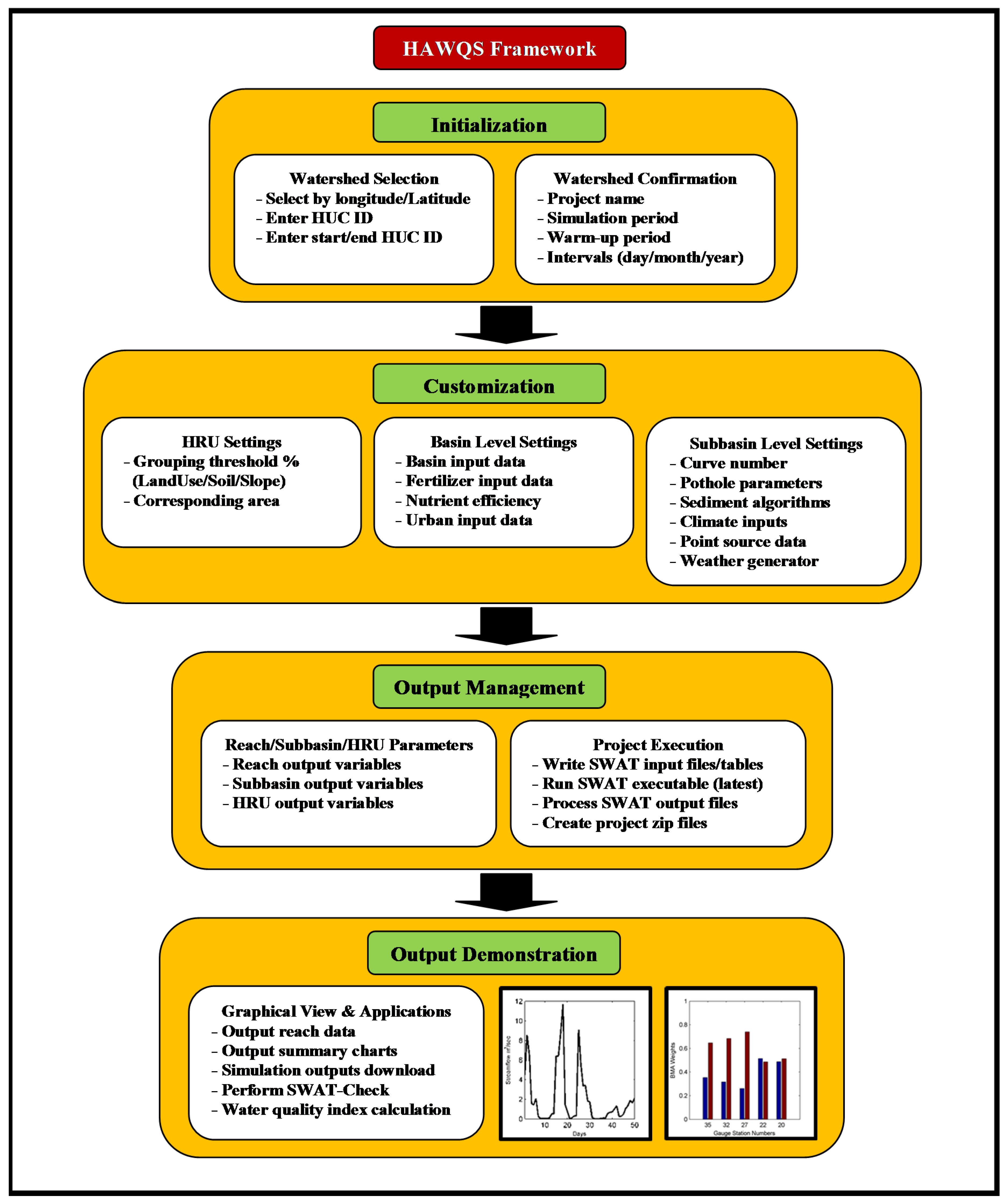
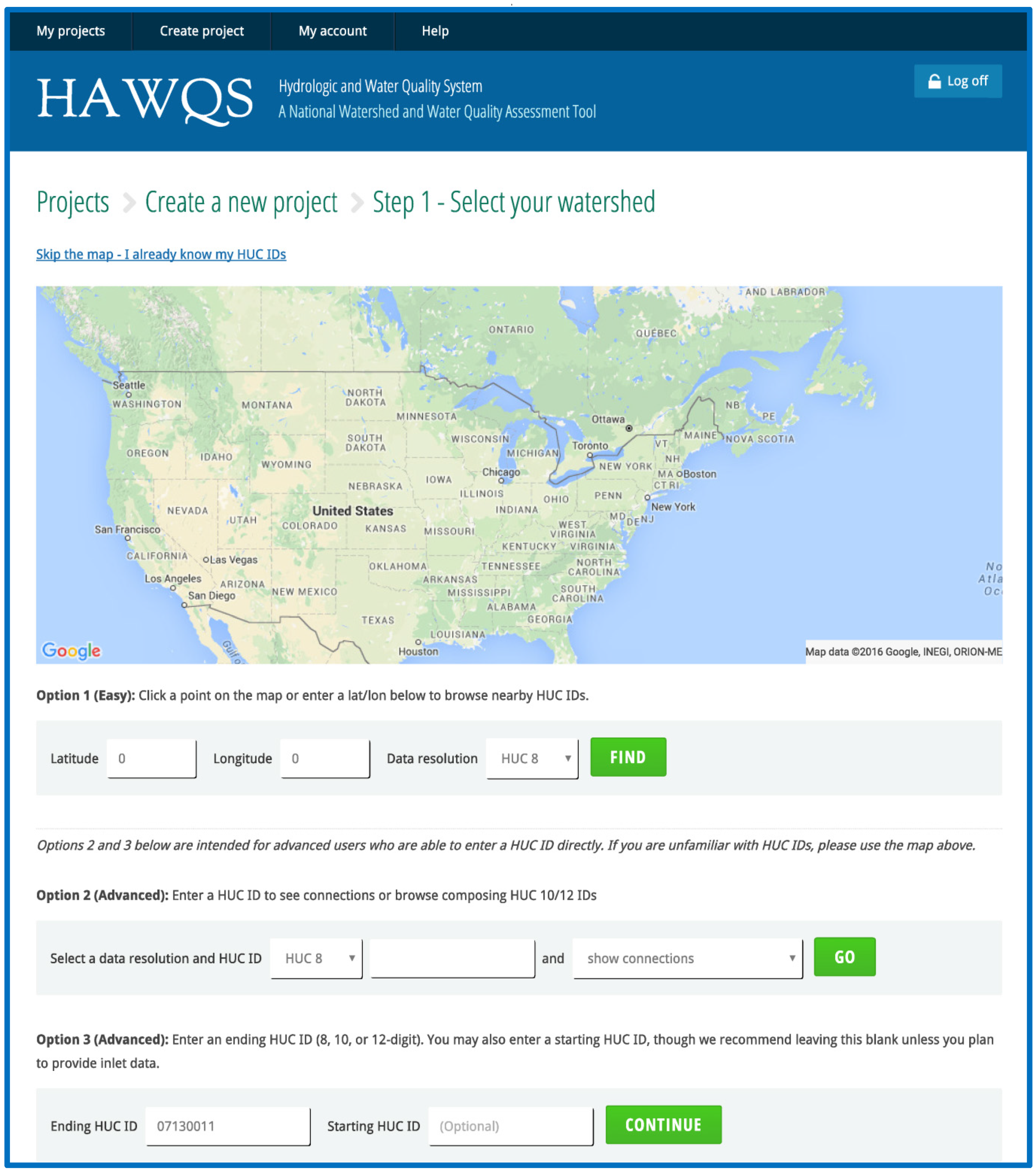
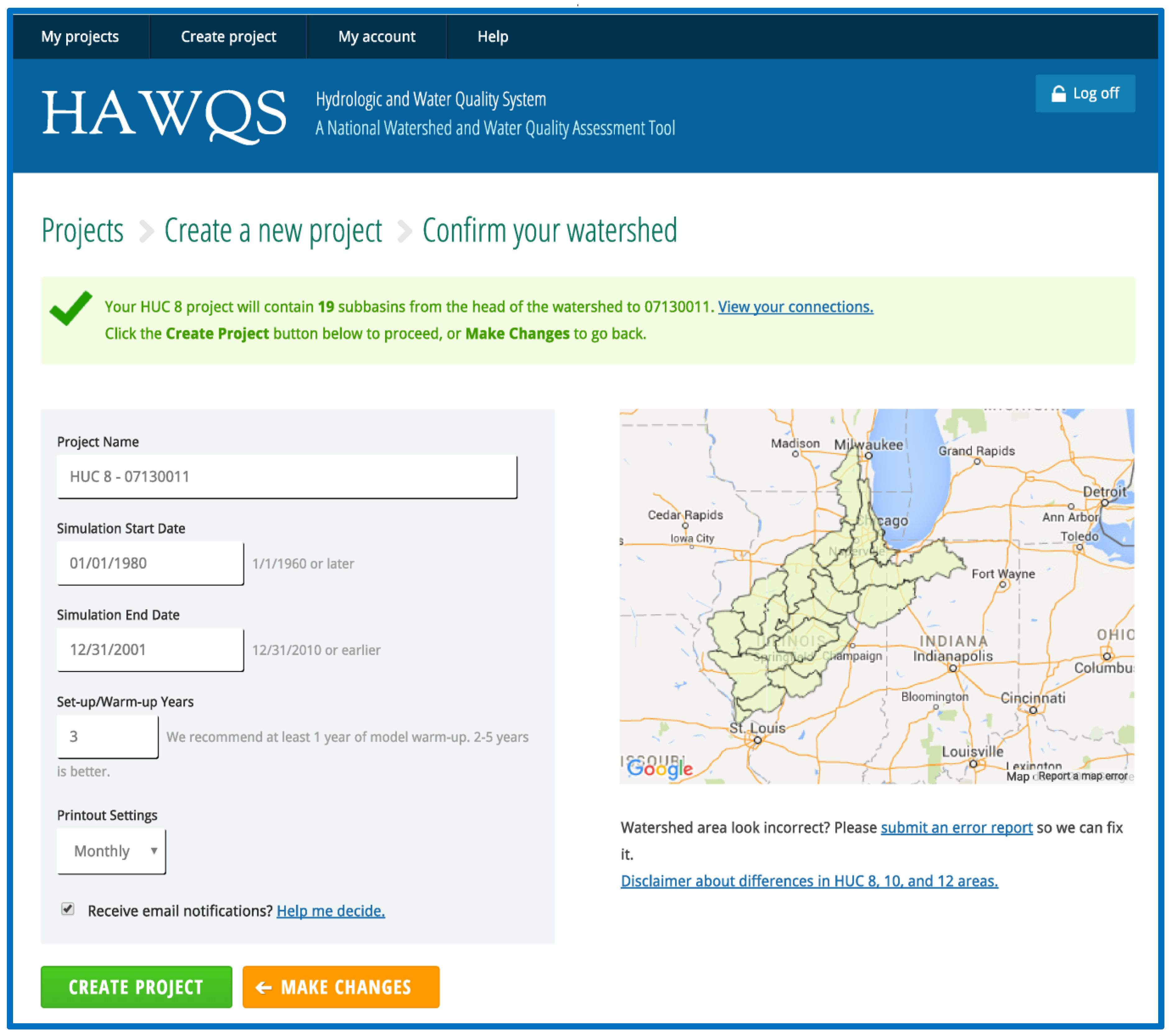
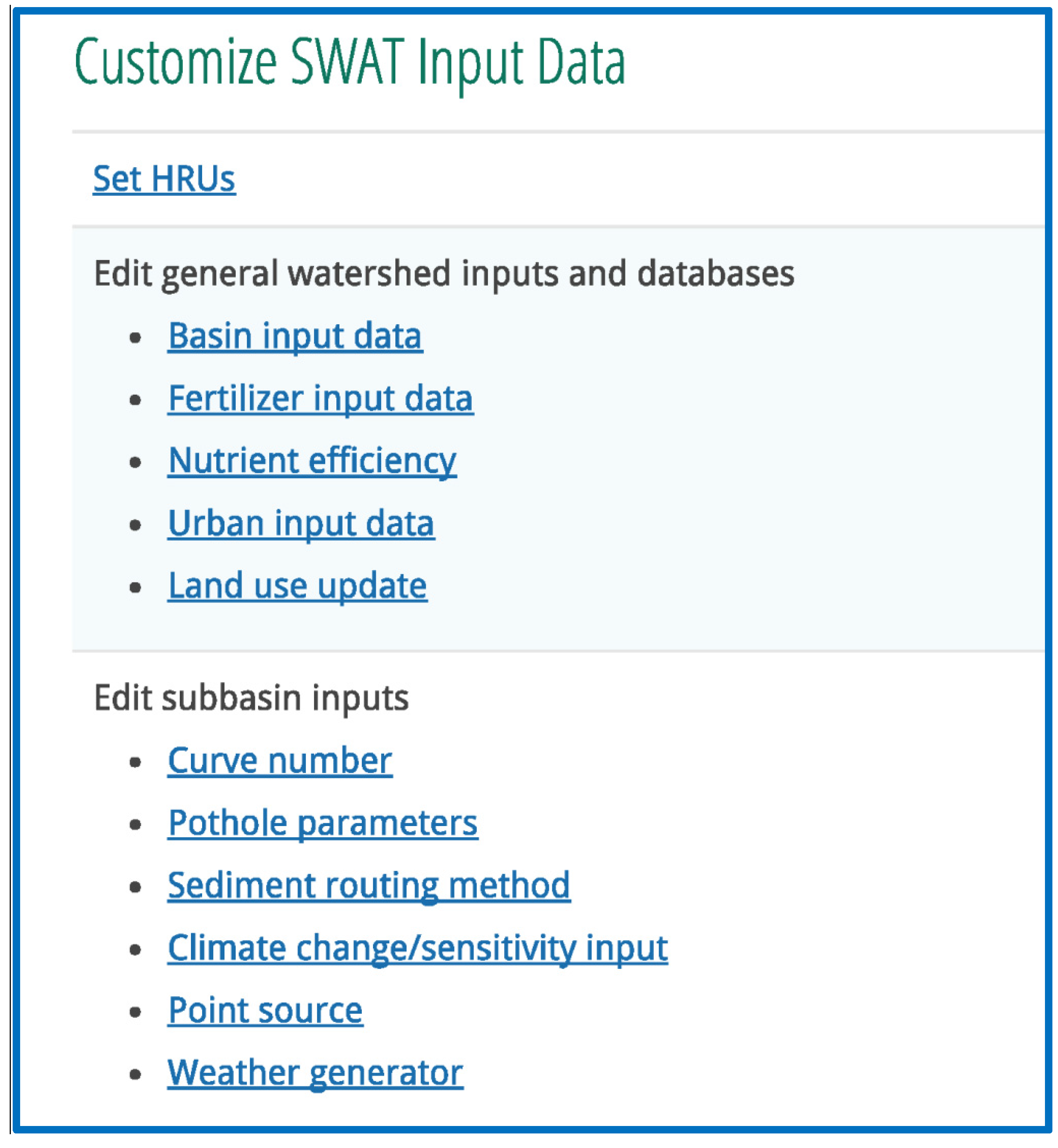
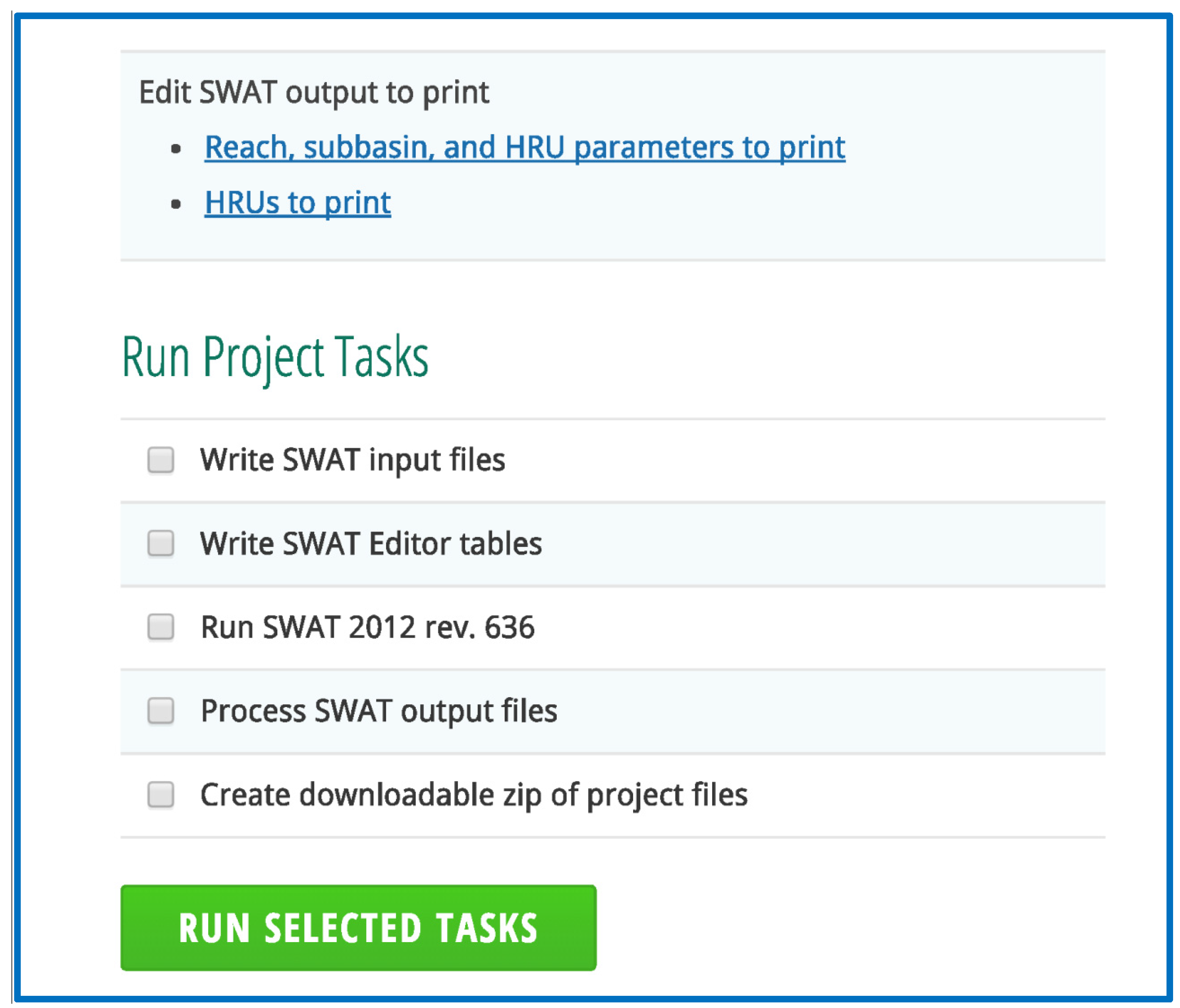
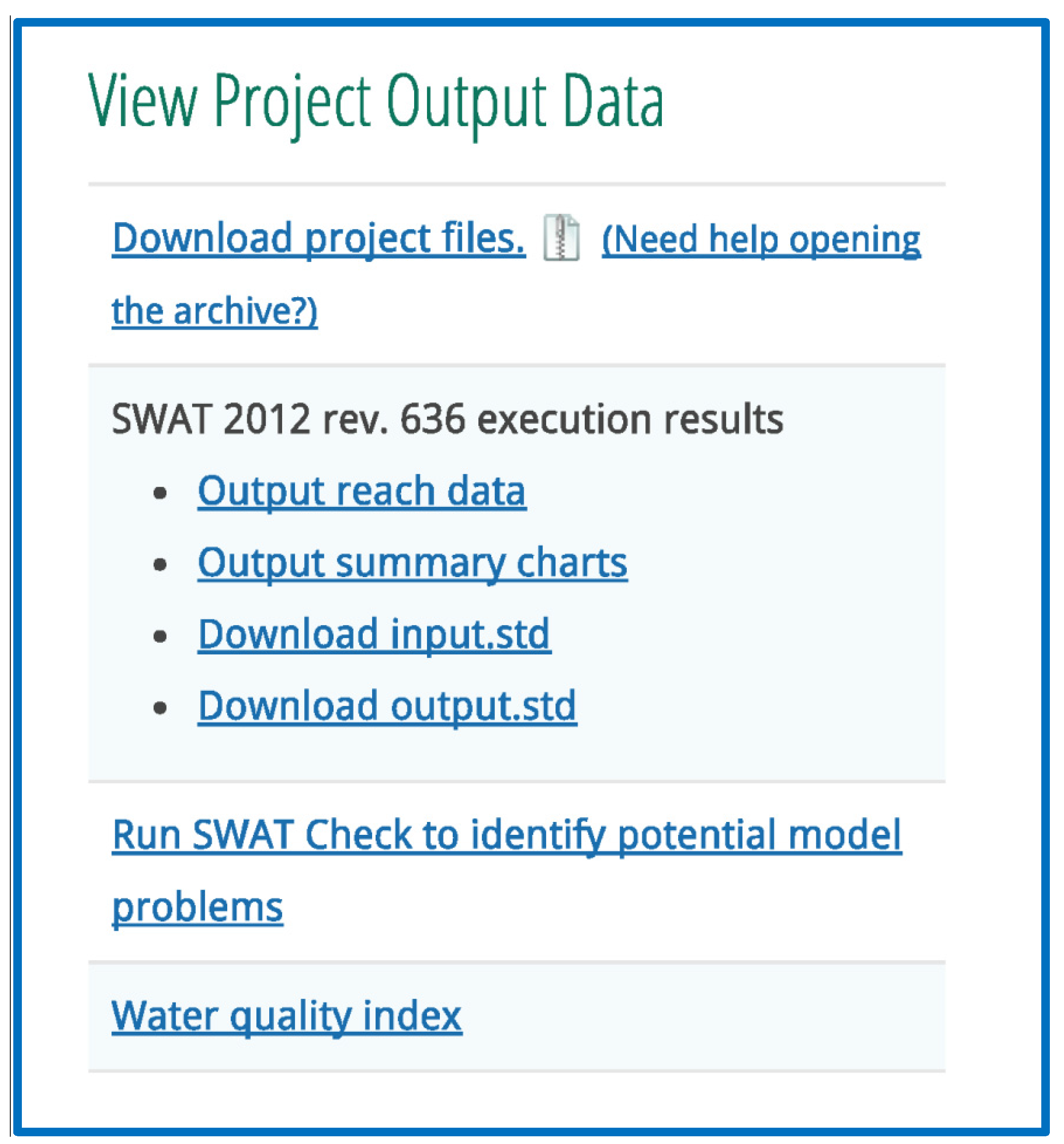
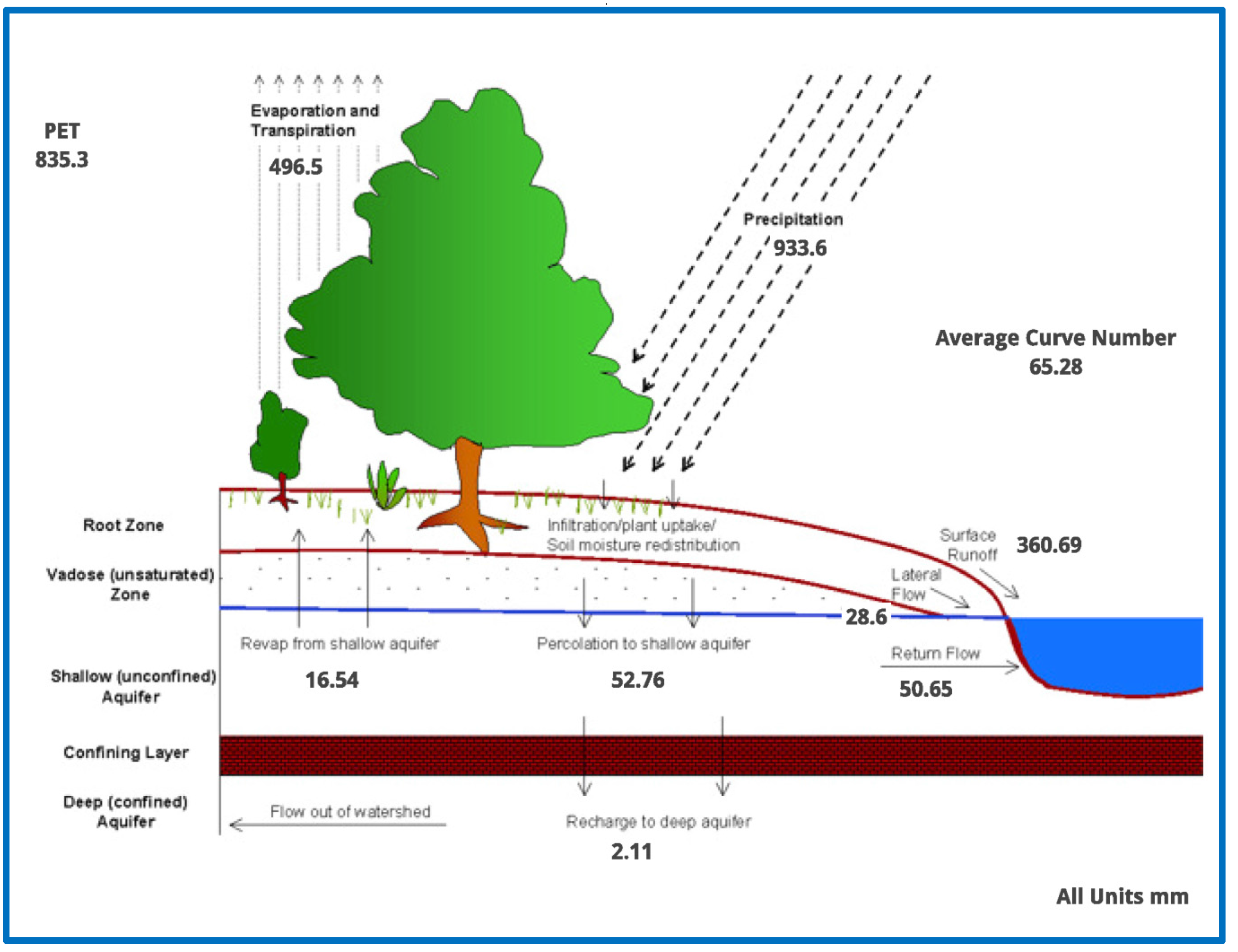
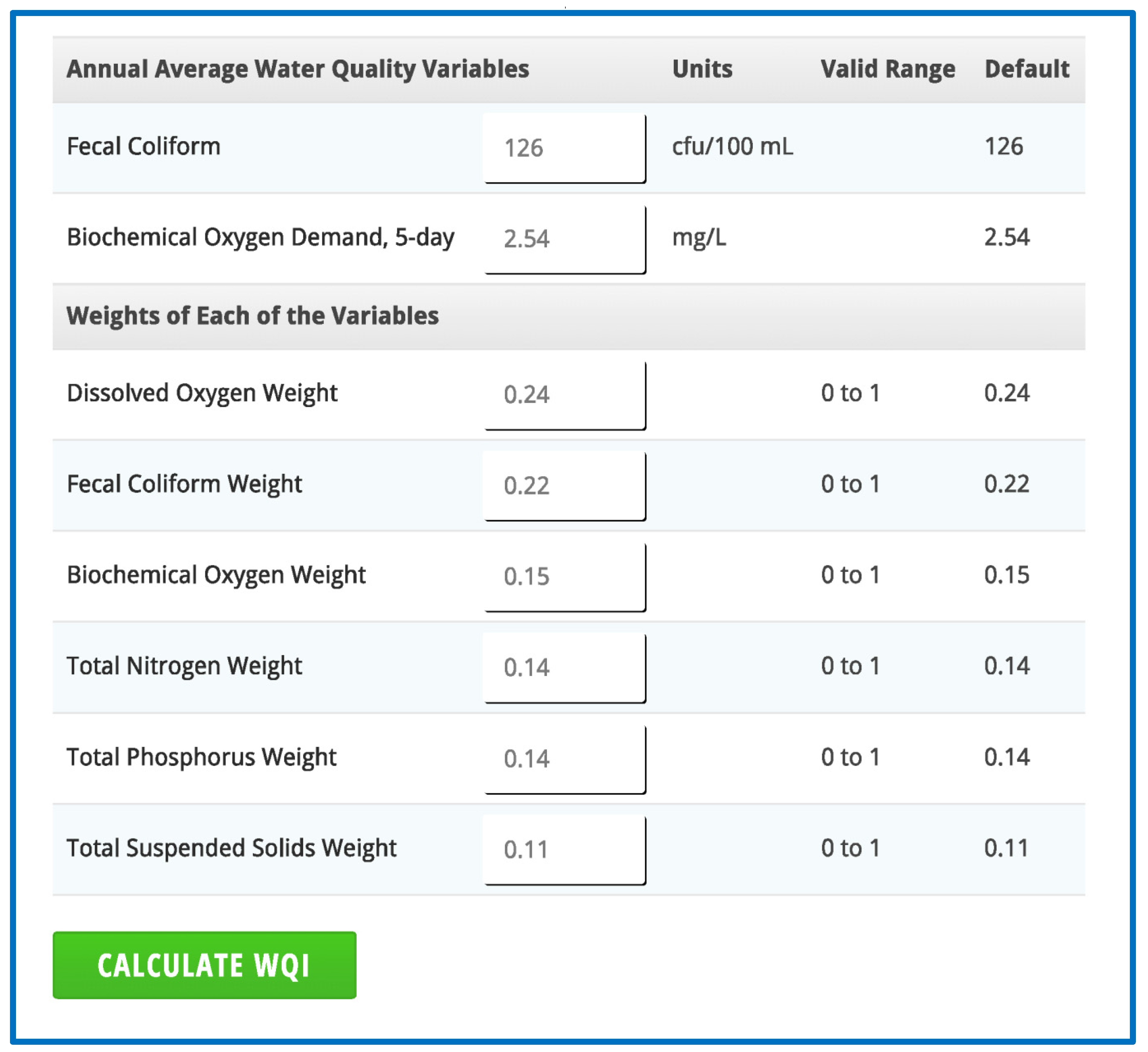
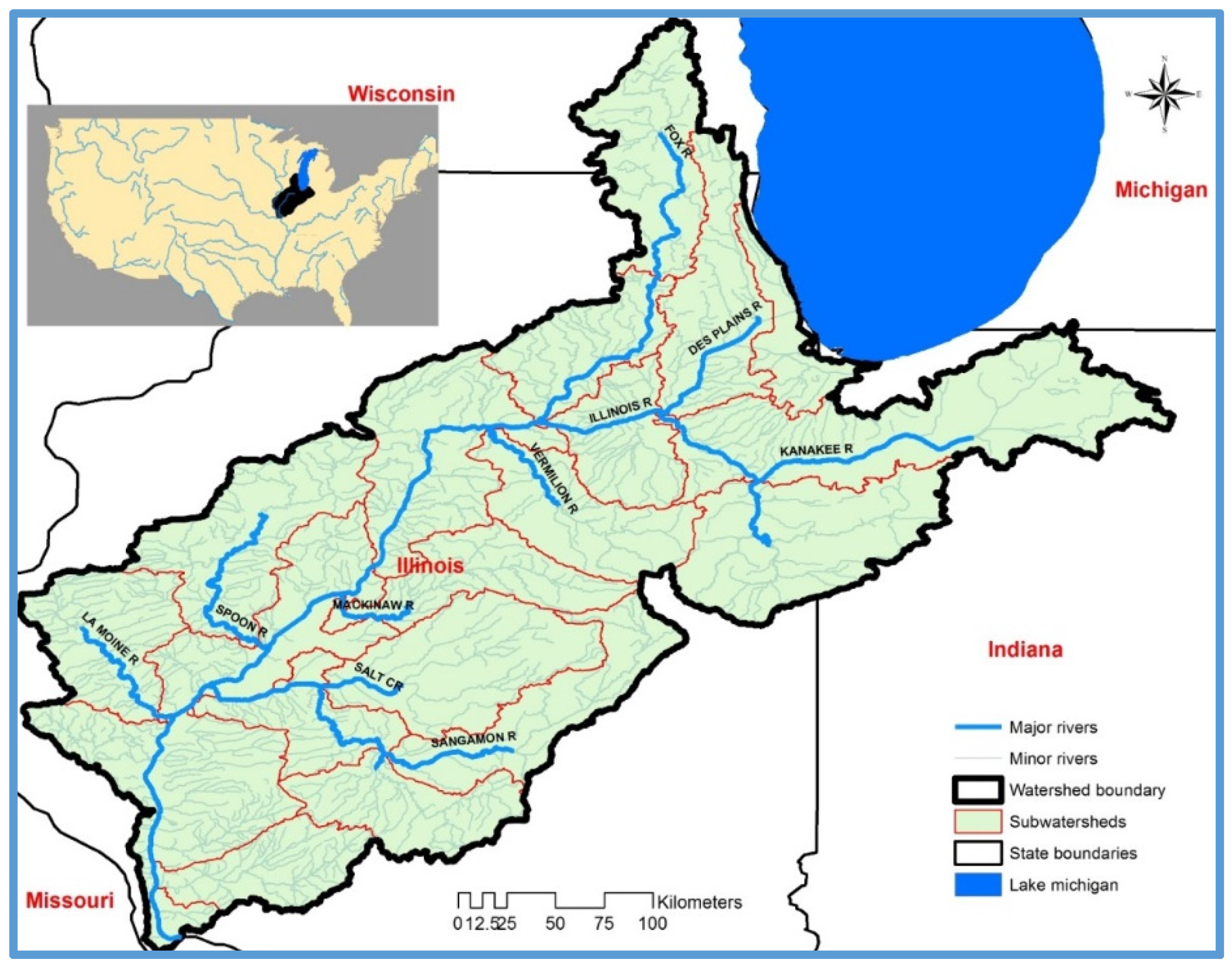
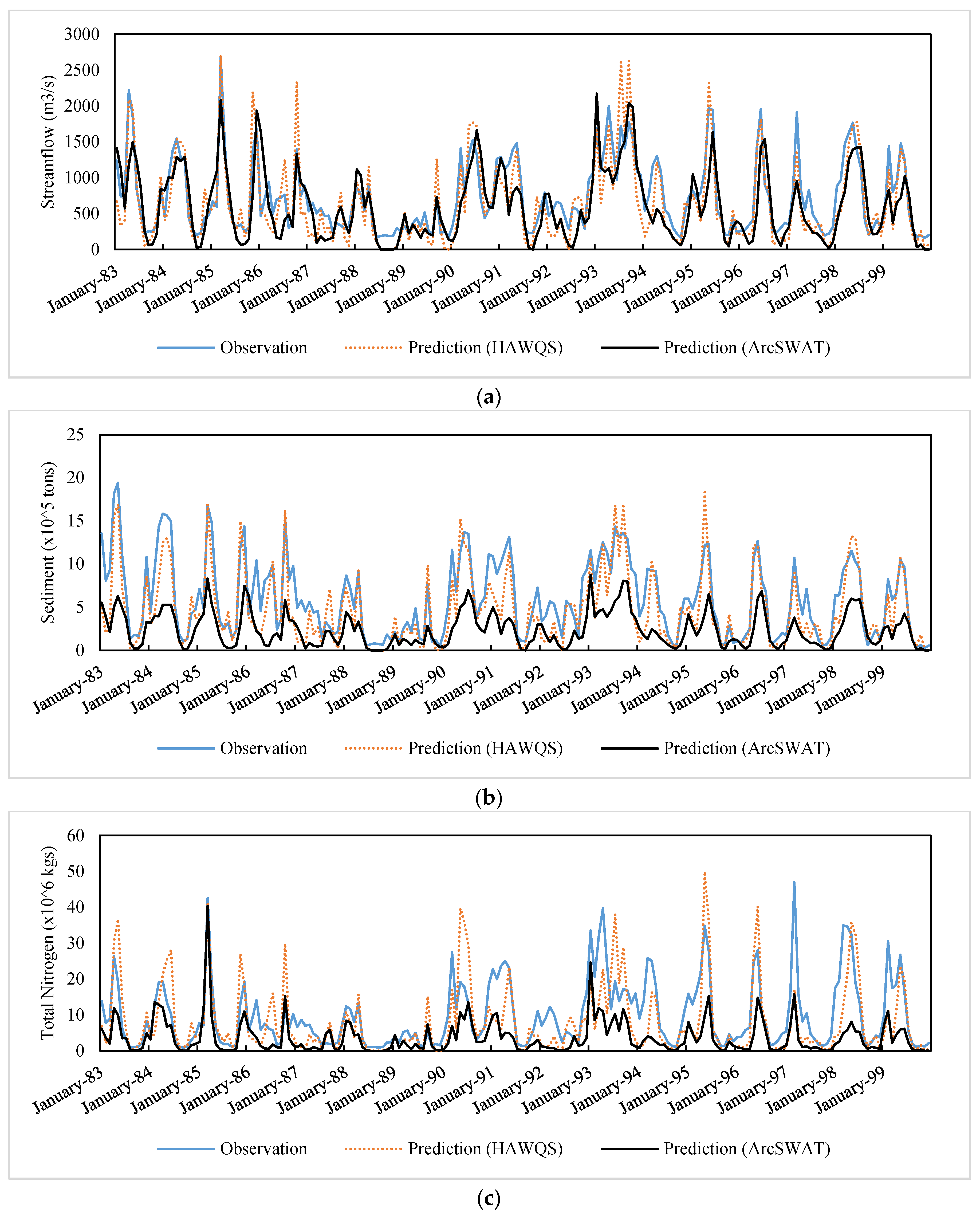
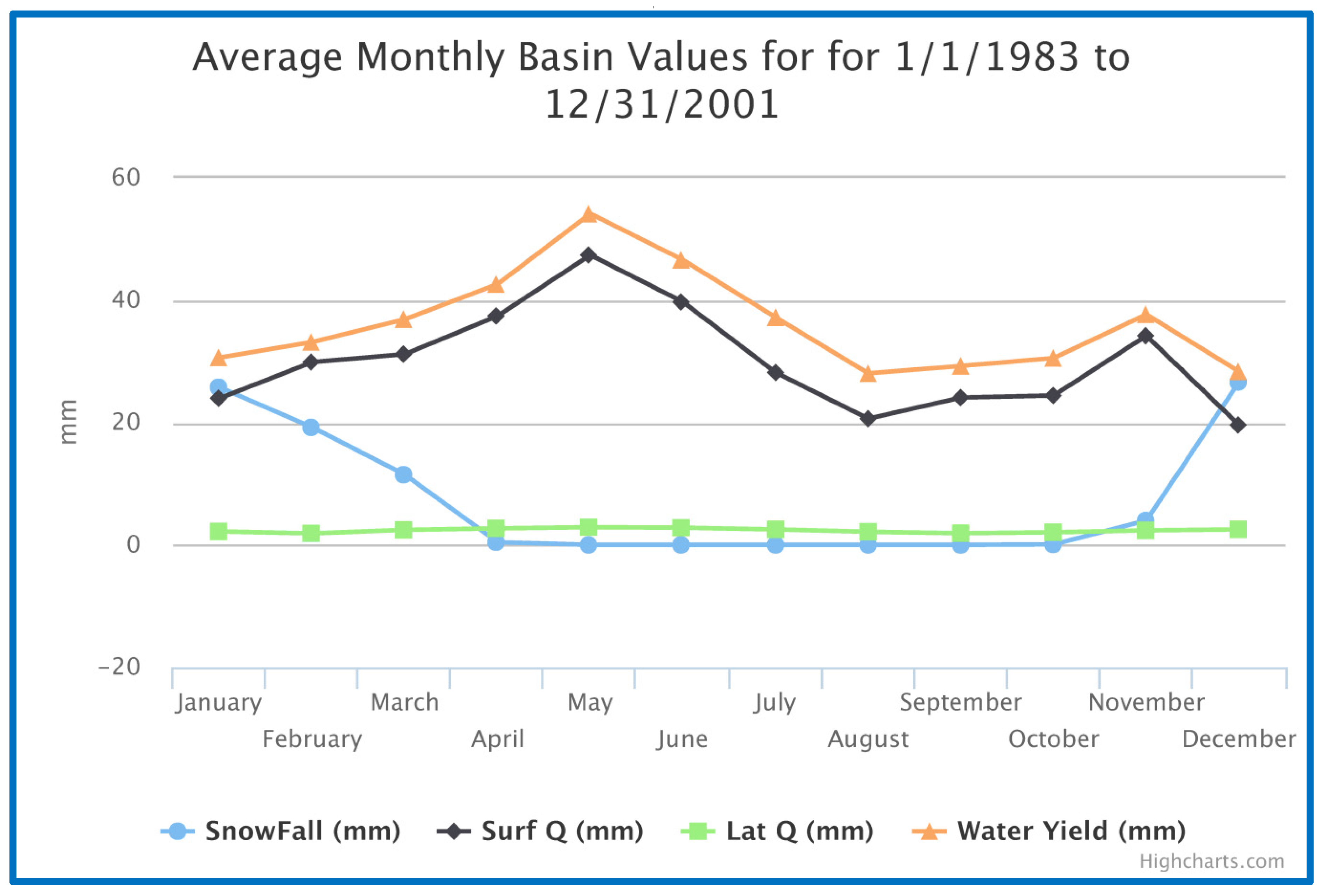
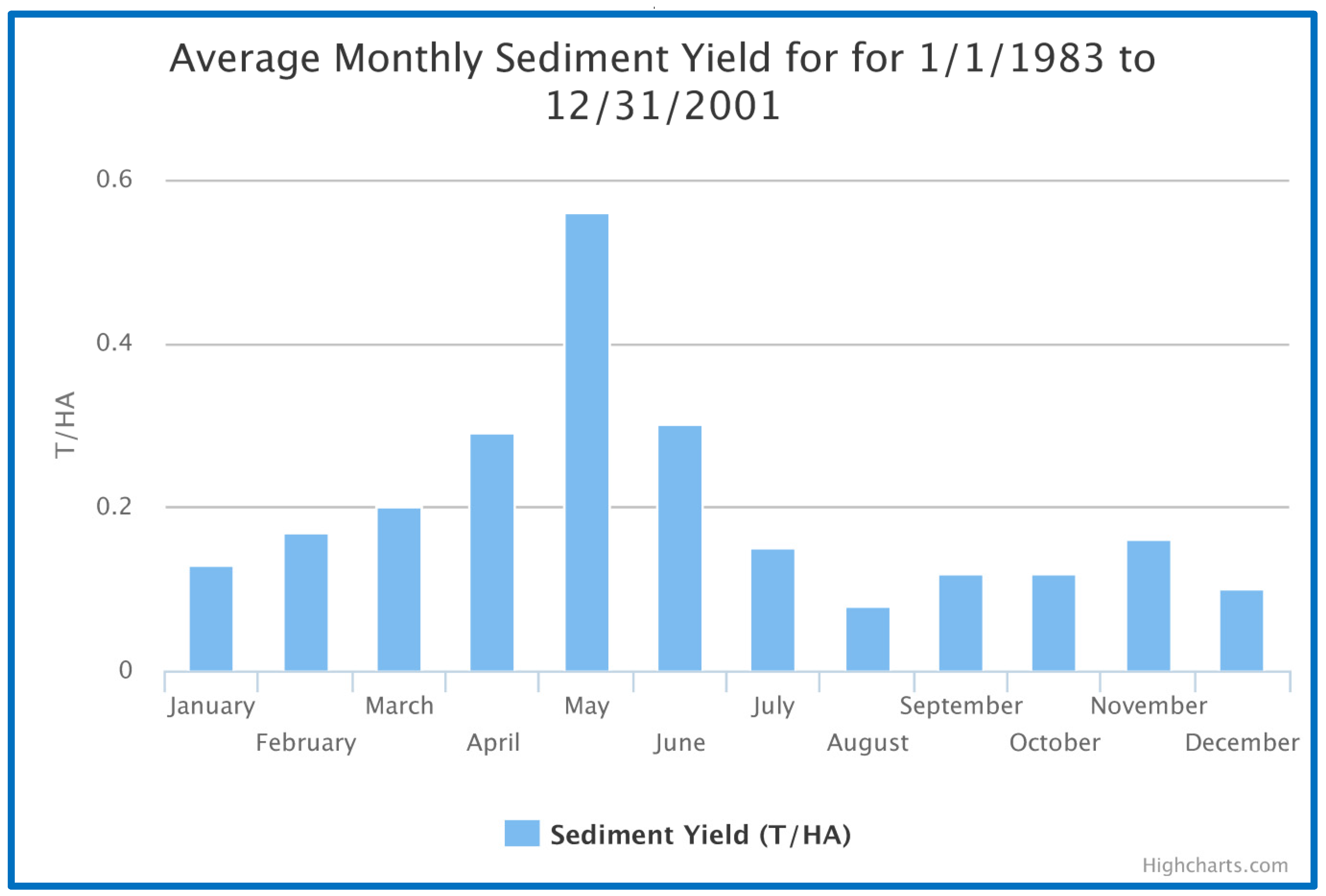
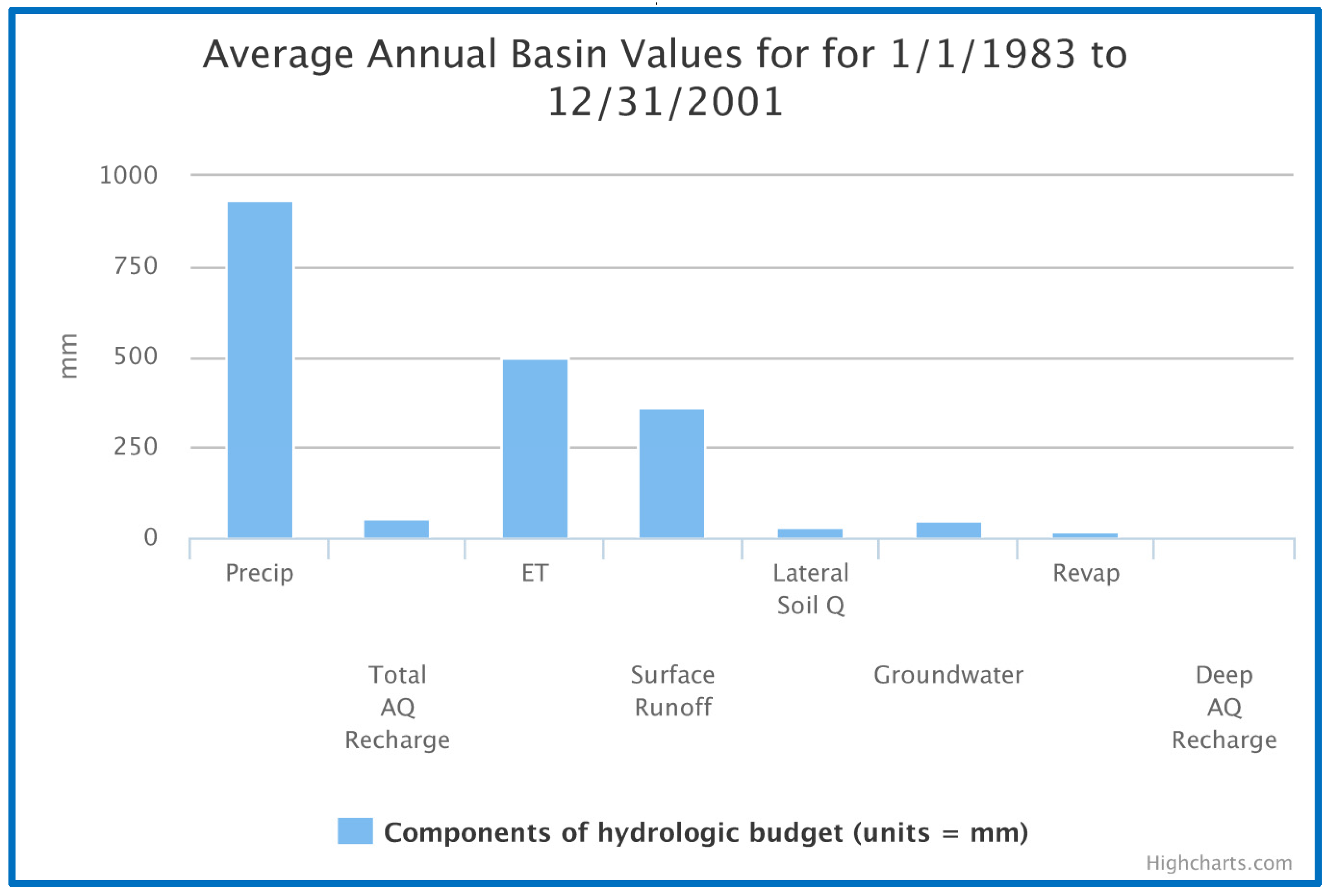
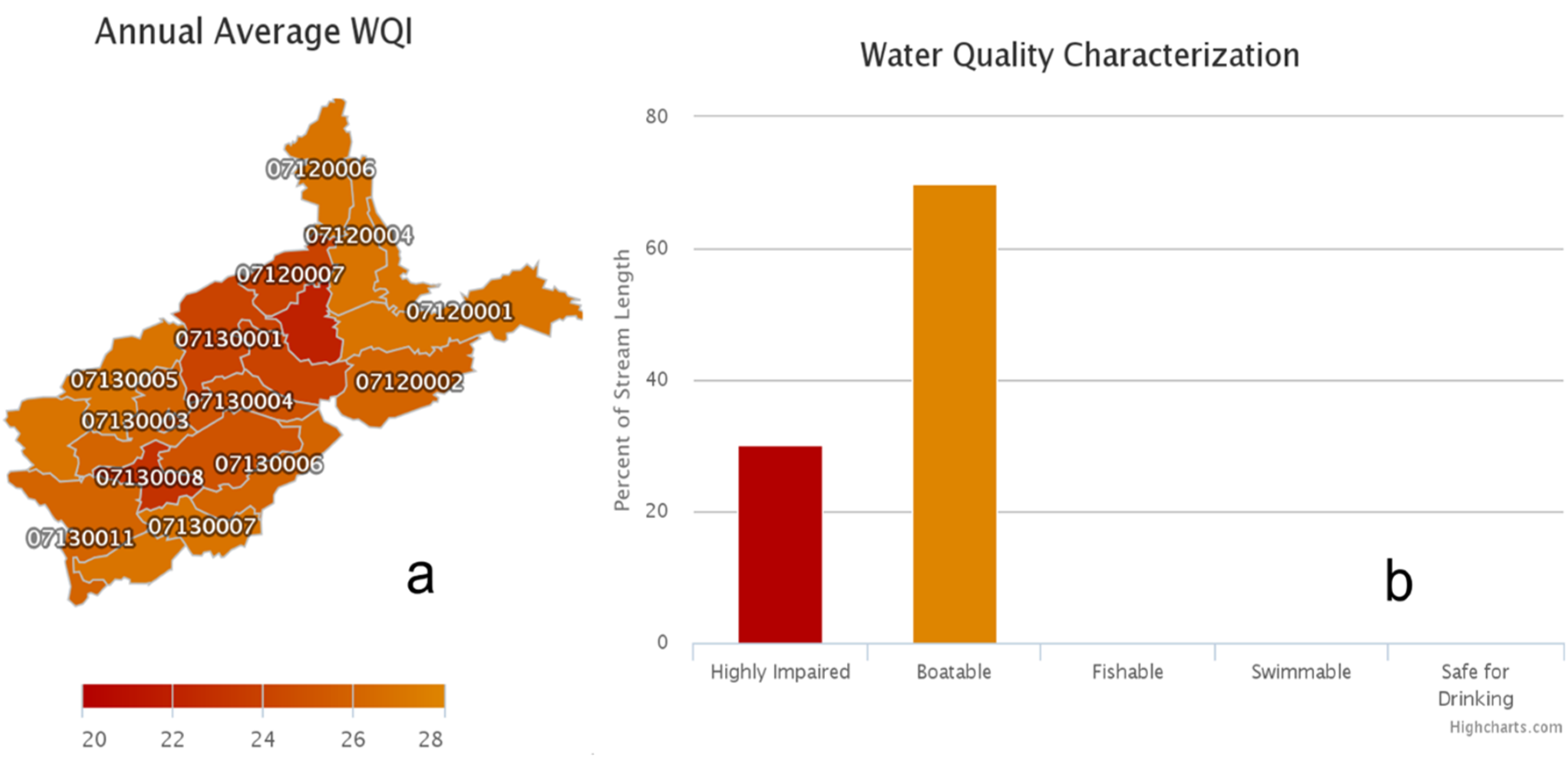
| Output Variables | IRW (HAWQS) | IRW (ArcSWAT) | ||||||
|---|---|---|---|---|---|---|---|---|
| Calibration | Validation | Calibration | Validation | |||||
| NSE | PBIAS (%) | NSE | PBIAS (%) | NSE | PBIAS (%) | NSE | PBIAS (%) | |
| Flow | 0.70 | 8.51 | 0.72 | 13.91 | 0.61 | 7.86 | 0.49 | 21.1 |
| Sediment | 0.66 | 26.55 | 0.67 | 19.07 | −0.05 | 61.56 | −0.14 | 57.86 |
| Total Nitrogen | 0.36 | −4.15 | 0.23 | 26.78 | 0.26 | 45.14 | −0.22 | 68.54 |
| Performance Rating | NSE | PBIAS (%) | ||
|---|---|---|---|---|
| Streamflow | Sediment | Nitrogen | ||
| Very Good | 0.75 < NSE ≤ 1.00 | PBIAS < ±10 | PBIAS < ±15 | PBIAS < ±25 |
| Good | 0.65 < NSE ≤ 0.75 | ±10 ≤ PBIAS < ±15 | ±15 ≤ PBIAS < ±30 | ±25 ≤ PBIAS < ±40 |
| Satisfactory | 0.50 < NSE ≤ 0.65 | ±15 ≤ PBIAS < ±25 | ±30 ≤ PBIAS < ±55 | ±40 ≤ PBIAS < ±70 |
| Unsatisfactory | NSE ≤ 0.50 | PBIAS ≥ ±25 | PBIAS ≥ ±55 | PBIAS ≥ ±70 |
| Comparisons | HAWQS | ArcSWAT |
|---|---|---|
| Graphical Demonstration | Available | Not Available |
| Available to assign preferred parameter values | Available | Not Available |
| Available for remote simulation | Available | Not Available |
| Data Collection | No Need | Required |
| Calibration requirement | No Need | Required |
| Required Software | No Need | ArcSWAT |
| Required Hardware | Regular Desktop | Regular Desktop |
| Spatial resolution | 3 Options | Not Available |
| Operation time | Few Minutes | Hours at Minimum |
© 2016 by the authors; licensee MDPI, Basel, Switzerland. This article is an open access article distributed under the terms and conditions of the Creative Commons Attribution (CC-BY) license (http://creativecommons.org/licenses/by/4.0/).
Share and Cite
Yen, H.; Daggupati, P.; White, M.J.; Srinivasan, R.; Gossel, A.; Wells, D.; Arnold, J.G. Application of Large-Scale, Multi-Resolution Watershed Modeling Framework Using the Hydrologic and Water Quality System (HAWQS). Water 2016, 8, 164. https://doi.org/10.3390/w8040164
Yen H, Daggupati P, White MJ, Srinivasan R, Gossel A, Wells D, Arnold JG. Application of Large-Scale, Multi-Resolution Watershed Modeling Framework Using the Hydrologic and Water Quality System (HAWQS). Water. 2016; 8(4):164. https://doi.org/10.3390/w8040164
Chicago/Turabian StyleYen, Haw, Prasad Daggupati, Michael J. White, Raghavan Srinivasan, Arndt Gossel, David Wells, and Jeffrey G. Arnold. 2016. "Application of Large-Scale, Multi-Resolution Watershed Modeling Framework Using the Hydrologic and Water Quality System (HAWQS)" Water 8, no. 4: 164. https://doi.org/10.3390/w8040164
APA StyleYen, H., Daggupati, P., White, M. J., Srinivasan, R., Gossel, A., Wells, D., & Arnold, J. G. (2016). Application of Large-Scale, Multi-Resolution Watershed Modeling Framework Using the Hydrologic and Water Quality System (HAWQS). Water, 8(4), 164. https://doi.org/10.3390/w8040164









